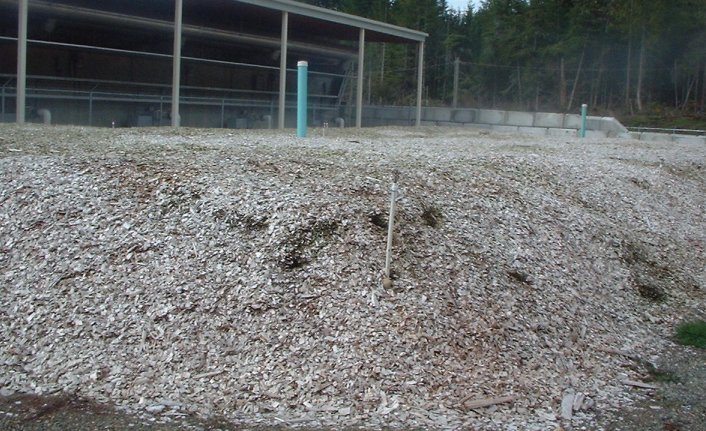Biofilter
From Wikipedia: Biofiltration is a pollution control technique using living material to capture and biologically degrade pollutants. Common uses include:
- processing waste water
- capturing harmful chemicals or silt from surface runoff
- and microbiotic oxidation of contaminants in air.
Pioneering work at New Alchemy Institute
In the 1980s, New Alchemy Institute experimented with composting inside a greenhouse. The goal was to use the heat and capture the CO2 released from the composting process to heat up the greenhouse and enrich the air with CO2 for more rapid growth. This worked amazingly well but they noticed that the compost sometimes produced bad odors that made it unpleasant to work in the greenhouse. The problem was solved by venting air from the compost and piping it into soil under slight pressure. The soil microbes acted as a biofilter, trapping the smells. Potential airborne pathogens may also be trapped and eliminated in this way. For more information about the NAI Composting Greenhouse, read the report, published in 1986 (internal copy here)
Specific Applications
- odors from composting facility or animal housing is pumped into an air biofilter
- methane emissions from lifestock manure can also be scrubbed in this way (see references [1] and [2]).
- vented gases from silage => air biofilter
- CO2-rich off-gas from a biogas facility => air biofilter, then greenhouse
- exhaust from combustion may also be treated in this way. Some jurisdictions may have strict emissions regulations that do not allow for open combustion and release. The filtered exhaust may then be clean enough to be used for CO2 enrichment in a greenhouse; examples are feed (duckweed, azolla, etc.) or biomass (bamboo, cattails, hemp, etc.)
- aquaponics: the wastewater from a fish tank (pond) can be used in a plant-based stage for growing duckweed, azolla, cattails and other plants. Alternatively, a biofilter may also be used (pros and cons to each approach).
Materials Needed (and Product Ecology)
- matrix materials: wood chips or wood wool; hemp shiv; shredded cattails; biochar
- fans to move air, ducting
- moisture control system (spray nozzles, drip)
- monitoring/management mechanism (either human or machine)
- ultimate disposal of the material: use in compost or to be combusted (after drying); good to locate biofilter in proximity to these other uses
- air biofilters may use up a lot of water (through evaporation) and this should be factored in (cost, infrastructure, etc.). There is the potential for using wastewater from other processes to achieve moisture maintenance (greywater, wastewater from aquaponics, etc.)
Management Issues
Being a biological system, the biofilter has to be carefully managed. With an air biofilter, the large amounts of air pumped through it may put the system at risk of drying out. Moisture has to be monitored and maintained (e.g. with spray nozzles, drip irrigation, etc.). Another risk is compaction, when the matrix is laid down too tightly for air to pass through. The possibility of system failure (fan failure, pump failure, etc.) has to be taken into consideration.
Videos (University of Minnessota)
1. "Biofilter Basics"
2. "Biofilters to Manage Odors and Air Emissions from Animal Feeding Operations" (University of Minnessota):
Links
- The soil biofilter is actually an older idea - see US Patent # 2,793,096 from 1957.
- Cornell University: "Odor Treatment - Biofiltration"
- No Tech Magazine: "How to Build a Biosand Water Filter Using a Wood Mold"
